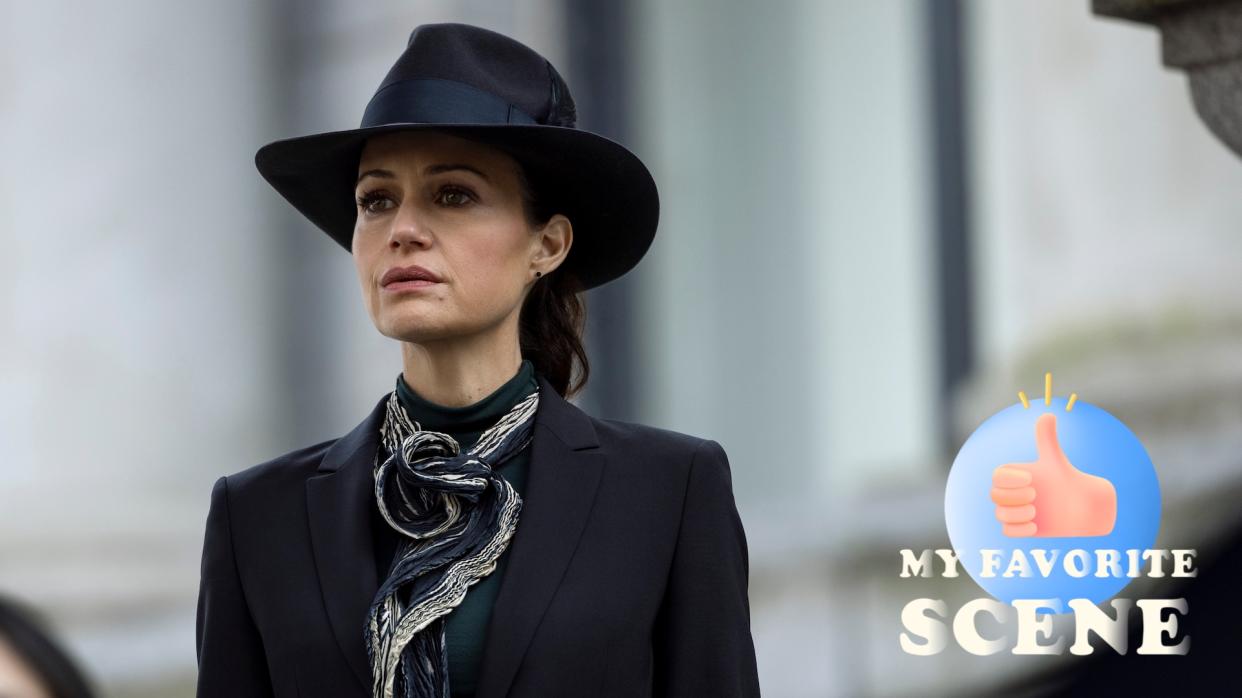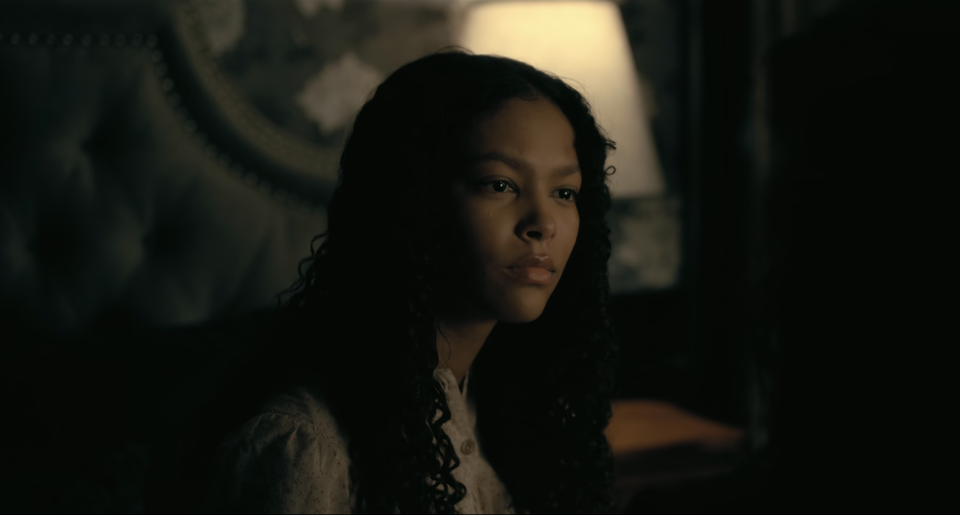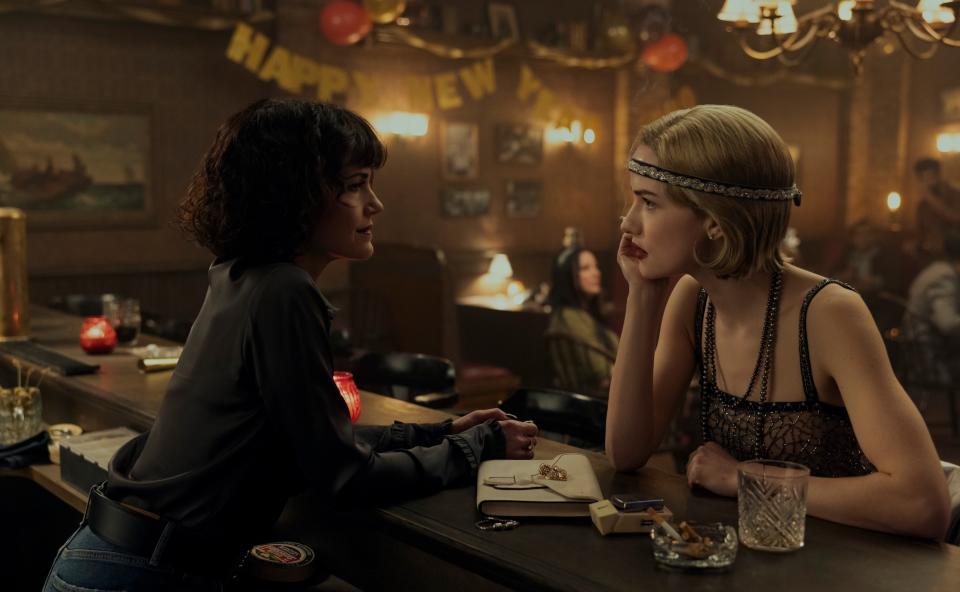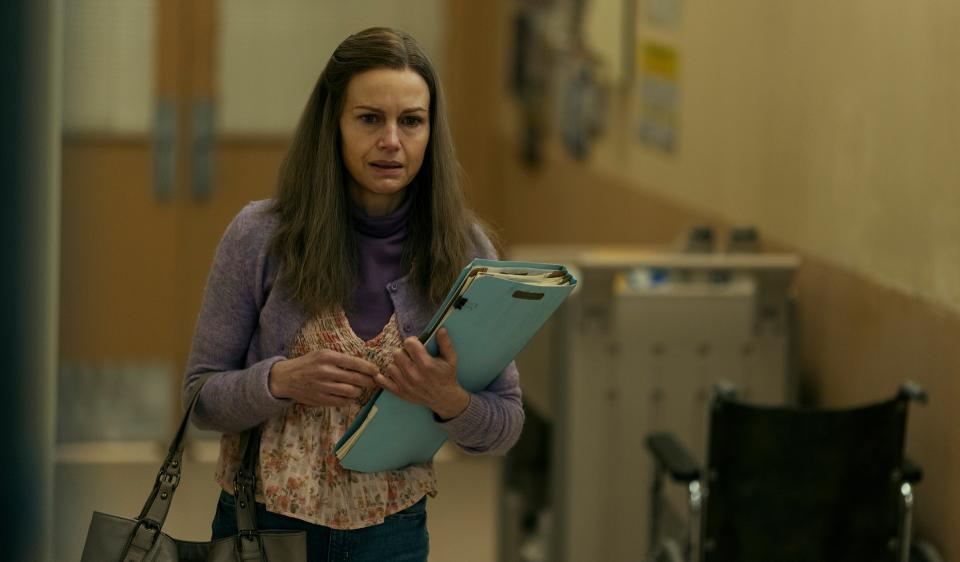Carla Gugino’s Favorite ‘House of Usher’ Scene Went Against Every Natural Instinct

- Oops!Something went wrong.Please try again later.
- Oops!Something went wrong.Please try again later.

Welcome to My Favorite Scene! In this series, IndieWire speaks to actors behind a few of our favorite television performances about their personal-best onscreen moment and how it came together.
Editor’s note: The following interview contains spoilers for Netflix’s “The Fall of the House of Usher.”
More from IndieWire
Much like her character in Netflix’s “The Fall of the House of Usher,” Carla Gugino is an actor who feels like she’s everywhere.
From her film work in “Gerald’s Game,” “Spy Kids,” “Watchmen,” and more, to TV roles dating back to “Saved by the Bell” through “Entourage” and as recent as “The Girls on the Bus” on Max (I had to spare a few moments of our interview to bring up Greg Berlanti’s “Political Animals”), Gugino feels as powerful, versatile, and ubiquitous as Verna, the shape-shifting devil puppeteering the eponymous fall.
But even with more than 20 years in the industry — “It doesn’t feel like that much time could have passed,” she told IndieWire — Gugino has never been one to claw at the spotlight, yet consistently delivers outstanding performances. In “House of Usher,” she puts years of studying subtlety to work as Verna a.k.a. the Raven, the harbinger of death whose bill comes due against the greedy, powerful Usher family. Gugino told IndieWire that her performance was partially inspired by Jessica Lange in “All That Jazz.”
“It’s a very different movie totally, but the idea was that Verna sees these people exactly as they are and she is not judging them for that,” Gugino said. “She’s just receiving it, completely. She knows that mostly, 99 percent of the time that you offer a human being everything they want — regardless of the ramifications, even if you tell them future ramifications — they will take it. And it’s that one percent that doesn’t that keeps her curious about humanity.”
That one percent is what forms the basis of Gugino’s favorite scene in the series. As Verna makes her way through killing off the Usher bloodline (per her agreement with siblings Roderick and Madeline years ago), she ends up face-to-face with Lenore (Kyliegh Curran), the solo grandchild. Unlike her entitled and corrupt older relatives, Lenore is simply good. She cares about her mother and grandfather, she calls for help when she realizes that her father abused the trust of his marriage. She’s pure enough that even her short life strengthens humanity, and Verna tells her all about that impact.
“While Verna has to kill Lenore — there’s no choice, she is part of that deal, that’s not in her purview to make that decision — she feels very strongly that she has to tell her ‘Your mother and you, that lineage will also continue and that will be a hugely positive impact on the world,'” Gugino said. “I think that that is actually the balance of the universe right there. When we die, we don’t know the context of our lives in the way that in this case, Verna can give her. For this young woman, she wants her to know so clearly that she isn’t just born of horror, and she isn’t just born of selfish behavior. She’s actually a product of something really powerful.”
The following interview has been condensed for length and clarity.

Carla Gugino: It’s hard always to pick favorites, but one that really does consistently spring to mind for me because it happened initially when I read the script, and remained through filming and now even after. I think it’s because it’s a scene that is so different than the rest of the show, and that it’s thematically really important to the balance of the show. Verna is, you know, not human, and doesn’t have your usual, what we consider like human morality. She doesn’t look at the world that way.
It was really key to me also that she retain this kind of curiosity, because if she was a character who knew the way everything was going to go, then it’s not as interesting to play but it’s certainly not as interesting to watch. She is impartial, that she is the Hand of Fate, and that that is her job and she’s laid it out very clearly, she’s not manipulated anyone, she’s not hidden the truth anywhere — she has laid it out and they have taken the deal.
One of the reasons that I really love working with Mike personally is he will always go to a deeper theme. He will always go to something that we as humanity should look at, within the confines of a very entertaining show. In this case, it’s the the cost and the ramifications of our actions and hubris. We see many ways in which there’s this ripple effect of negativity and of horror and of death and all of these things from the Ushers.
I cried when I read that scene. Oftentimes, as an actor, you’re thinking, “What would I do in this situation?” And this was the opposite. This was, “No, actually what I would do is I would hug this girl, I would cry, and I would try to figure out any way to save her,” but I thought what was so interesting about exploring this was Verna has to remain impartial. It’s also lovely to break rules of a character; if you have a character, in this case that’s not human and that’s impartial, and is someone who theoretically shouldn’t be moved by something like this but is — that’s always an interesting moment to me. So the challenge of that scene for me was really not allowing the audience to feel it and not for Verna to feel it, but for Verna to clearly give her a sense that when she dies, she will know she made an impact on the world that was really beautiful.
IndieWire: This is very much an ensemble piece, but how is it participating in that when most of your scenes are with one or two people? There’s a lot of big family Usher scenes and funerals, but yours are very contained.
It was such a pleasure and so interesting. I’m very emotional person and an emotional actor in the sense that emotion is interesting to me and so much part of the fabric of so many characters — Olivia in “The Haunting of Hill House” or certainly in “Gerald’s Game,” “Bly Manor,” these are all really emotional characters. It’s one of the things that I am so grateful to [Flanagan] about is that he always presents you with something that you haven’t done. In this case, it was so fascinating and so cool. Also, because in most of those scenes with each of those other actors, it’s sort of their major scene. It’s the crisis of that character, and I just got to kind of witness it and figure out what I could do to help bring that out in them. And because Verna was like a raven on a perch, it was such a cool and unusual position to be in.
A lot of those one-on-one debt scenes have a kind of a “Who are you?” or a recognition of Verna, and then just kind of monologue. You’re still having a scene partner, there’s still that give and take, but how does that work when the majority of the dialogue is on you?
I think Lenore is the personification of innocence, and in a way Kyliegh has that. The moment I looked at her, I was like you’d never want to do a bad thing to this person. One of the hardest things in acting is listening, and that’s when you can really tell a great actor is how they listen, and just her quality of listening. It was also interesting because that scene by nature is she’s receiving information that she doesn’t know. Verna needs to lay it out for her very clearly, whereas the other deaths are very much giving these people an option to make a different choice, even if that different choice isn’t going to save them, it might save them on the other side, like they will actually perhaps have a chance to really know themselves before they go.
Or telling them what they already know, like “You’re a terrible person.“
The other key thing is that because she remains curious, she’s always there’s that one percent where she’s like, will they change? She mostly knows they won’t, but I think for this sort of flower to spring out of this horror makes [Lenore] even more special. It was really just a very easeful scene together, and she was a wonderful scene partner.
The interesting thing with this show too is that many of the actors I had known before. I had known that Mike had loved working with [Curran] and I was looking forward to working with her, but we didn’t know each other and we didn’t have a lot of time together on set before. We were able to meet at a table reading and a couple of other things. Michael Fimognari was directing that episode, and he really wanted the scene to rest on very little movement, being between the two of them. It’s an opportunity where we get to see what it costs Verna. All of that made that scene just very special to me. This show is very much about legacy, and I think that that was the important thing to impart, that she created also a legacy that she will not be there to see, but that will help the world.

It also looks like one of the more spare scenes, production-wise. You’re just sitting on the bed versus the Freddie death (Henry Thomas), which is this big VFX set piece.
That death scene was rich. Henry Thomas and I have worked together so many times now and he’s amazing. That was an incredible day for us to just delve in together, but so much of it was done later in post production. We had some elements to act with, but we were also having to imagine what was there, respond to that, and then they created some of that in post based on our responses. So that’s such a wild, different kind of collaboration. There’s that, there’s incarnating the ape which was hugely challenging in a different way. There were all these different challenges, but the fascinating thing that a scene that would be as simple as that one would be, in a way, a totally different challenge than I had in playing that entire character. The least flashy scene, but just not actually weeping was so difficult.
It’s very hard to get that kind of subtle, nuanced performance without coming across a little wooden and soulless. Even considering that Verna isn’t human, I really feel so much humanity in that character. Was that a particular challenge? Is that something that you worked on to bring scenes like that to life without letting them feel static and boring?
That means so much to me what you just said, because it was an evident challenge in the role. One of the things that I felt was really important and I spoke to Mike about and he definitely felt the same way was that each of the incarnations — she obviously comes in different forms to in a way that each of those people can receive her — that those be deeply human.
For example, the one who needs a heart transplant. That story is really important, because we have a very flawed medical system, we have so much fear around things, we have people who don’t give anybody information. And if you don’t have money and resources, you’re in a situation like that character is where she really feels like she doesn’t trust anyone anymore. She finally trusts one person and that person is just not trustworthy — and her life is at stake. What I needed to retain was this golden thread of Verona throughout, so there is an equanimity that is behind it. You always get a little Verna either at the end of a scene or more apparently when they’re coming in and out.
For that character in particular, you do it in the middle of one scene. She gets like a little flustered and you have the accent and then it just disappears. You’re briefly that and then back again.
That one was a real tightrope of a scene to play because of that. Again, just making sure that I was able to jump back and forth quickly and precisely enough. So therefore one of the reasons that I hope that you feel the humanity is that each of them are like a real person that she just sort of adopts, as opposed to her putting on a show. And then the thing that felt very key to me was that element of curiosity. Now we found out that she has been living for centuries, right? If every once in a blue moon, somebody is a Lenore, for example, she’s really heartened by that. She’s not ahead of the story in that way, because that’s the trap, right? The trap that makes it feel wooden or inaccessible is that like, “Haha, I know better than everyone else,” and it’s just not very interesting.
It’s so clear from our conversation how much thought and care has gone into crafting this character — how much of that comes out of your initial discussions with Mike or with the directors or you internalizing and going off and diving into this? Obviously, there’s text and more to pull from, but the show is such an amalgam of all of that.
It really is a combination of all those things you just said. Definitely Mike writes extremely precisely, so there’s a lot in there for you to work on. We’re interpreters, right? So basically I hope to elevate everything that’s on the page and make it better than they ever imagined it to be. But if you don’t have it on the page, then you don’t have that foundation.
For example, Mike didn’t write in any of the accents, so that ended up being something that he left up to me and I would sort of audition accents for him. The animal shelter worker, she has a feeling to me that’s like Midwest, she feels like she likes animals more than people, clearly. She’s also no-nonsense, and she has manners, and Rahul’s character does not have manners, and that really drives her crazy. So I said, I think she’s from the Midwest, and I started working on a specific accent that was just outside of Chicago, and he was like, “Yup, there she is.” So he starts with a very clear character and then I was able to build on it from there.
I also worked with Terry Notary, who’s a phenomenal movement coach — and more than that, really, he designed all the apes in “Planet of the Apes.” [In “The Square”], there’s one sequence where Terry, on camera looking like a human as he is, incarnates an ape in a very fancy dinner party. I’ve never seen anyone change the energy in a room so profoundly, he really freaked these people out in a really genuine way. I’ve been a big fan of his for a long time.
I really started working with him because of the cat and the Raven, and the chimp, and I wanted to sort of work on different body languages — and also I had to really work on different centers where each of these characters live, because there were certain days where we had to do two incarnations in the same day really quickly and so I needed to drop in really fast.

Even for Verna, you have to move so smoothly and gracefully. When you pick up the three glasses in that flashback, you just turn around and then you’re back with the bottle and three glasses. I would have fallen over! I would have found a way to fall over.
I really wanted her to be like smoke in and out of a room. So you’re very astutely noticing things that you wonder if they’re noticeable. Because Mike trusts me and I trust him, there’s this wonderful sort of collaboration — and Michael Fimognari, who directed half of the episodes, has been Mike’s D.P. for so many years and has worked with so many times, too. It’s a bunch of storytellers who are there to tell the same story.
A lot was informed by my wardrobe, Terry Anderson, the costume designer, and I really collaborated in terms of the feeling that we wanted her to have. As you see her in her most raven-like human incarnation, the black corset and the wing-like sleeves, I wanted her to feel like she was perched on a branch. She’s looking at the overview of everything, and then we go into it with these different characters. It was how you want collaboration to be, which is you have a very strong vision and piece of material to start with, and then you get to dig in and make it richer and richer.
Obviously, there is now this Mike Flanagan Netflix universe. It makes a difference as a performer coming into that kind of setting where you know people, but I would love to hear about developing that collaboration with your castmates, as well as the production team.
It’s sort of like a shorthand. You just skip a lot steps, which is great. Sets, like workplaces anywhere, we all understand it’s a huge amount of personalities especially if you throw in a bunch of artists, there’s just a lot of different energy going in a lot of different directions. That’s the case on every set. But for example, Bruce Greenwood and I had done “Gerald’s Game” together. So like Henry or like Kate Siegel, or Sam Sloyan — there’s so many wonderful actors that I’ve had the privilege of digging deep with on a multitude of occasions. It is like a theatrical company. I’ve always been, as a storyteller, interested in how can I serve the story? This is a group of actors that all feel that way.
Sometimes actors get bad reputations — and sometimes it’s true — because it’s like, “This is about my character” or that way of looking at telling a story. Mike has surrounded himself with people that are really good storytellers and also realize that we are all part of this fabric. In “The House of Usher,” there’s so many characters and the actors are so strong across the board, and I was inspired by every single one of them. It’s also a group of fearless actors, that I will say, and that’s actually key and very unique. [Mike] made a comment which made Verna a particularly exciting challenge; he said “The House of Usher” is like an orchestra, and each person is an individual player, and then Verna is a little bit like her own orchestra. But if you have two orchestras playing at the same time, they really have to be in key, just because she has to drive the action in so many ways.
“The Fall of the House of Usher” is now streaming on Netflix.
Best of IndieWire
Every Palme d'Or Winner from the Cannes Film Festival, Ranked
The 13 Best Thrillers Streaming on Netflix in May, from 'Fair Play' to 'Emily the Criminal'
The Best Father and Son Films: 'The Tree of Life,' 'The Lion King,' and More
Sign up for Indiewire's Newsletter. For the latest news, follow us on Facebook, Twitter, and Instagram.

